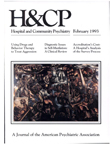Diagnostic Issues in Self-Mutilation
Abstract
Objective: Pathological self-mutilation-the deliberate alteration or destruction of body tissue without conscious suicidal intent-was examined both as a symptom of mental disorders and as a distinct syndrome. Methods: Data from more than 250 articles and books were reviewed, as well as data obtained by the authors from their extensive clinical experience in treating self-mutilating patients. Results and conclusions: The diverse behaviors that constitute pathological self-mutilation can be categorized into three basic types: major-infrequent acts that result in significant tissue damage, usually associated with psychoses and acute intoxications; stereotypic-fixed, rhythmic behavior seemingly devoid of symbolism, commonly associated with mental retardation; and superficial or moderate-behavior such as skin cutting, burning, and scratching associated with a variety of mental disorders. The authors propose that a syndrome of repetitive superficial or moderate self-mutilation should be regarded as an axis I impulse disorder. In most cases, the syndrome coexists with character pathology.
Access content
To read the fulltext, please use one of the options below to sign in or purchase access.- Personal login
- Institutional Login
- Sign in via OpenAthens
- Register for access
-
Please login/register if you wish to pair your device and check access availability.
Not a subscriber?
PsychiatryOnline subscription options offer access to the DSM-5 library, books, journals, CME, and patient resources. This all-in-one virtual library provides psychiatrists and mental health professionals with key resources for diagnosis, treatment, research, and professional development.
Need more help? PsychiatryOnline Customer Service may be reached by emailing [email protected] or by calling 800-368-5777 (in the U.S.) or 703-907-7322 (outside the U.S.).



